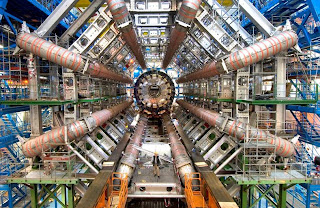The Big Bang is the cosmological model of the universe that is best supported by all lines of scientific evidence and observation. The essential idea is that the universe has expanded from a primordial hot and dense initial condition at some finite time in the past and continues to expand to this day. Georges Lemaître proposed what became known as the Big Bang theory of the origin of the Universe, although he called it his 'hypothesis of the primeval atom'. The framework for the model relies on Albert Einstein's General Relativity as formulated by Alexander Friedmann. After Edwin Hubble discovered in 1929 that the distances to far away galaxies were generally proportional to their redshifts, this observation was taken to indicate that all very distant galaxies and clusters have an apparent velocity directly away from our vantage point. The farther away, the higher the apparent velocity. If the distance between galaxy clusters is increasing today, everything must have been closer together in the past. This idea has been considered in detail back in time to extreme densities and temperatures, and large particle accelerators have been built to experiment on and test such conditions, resulting in significant confirmation of the theory. But these accelerators can only probe so far into such high energy regimes. Without any evidence associated with the earliest instant of the expansion, the Big Bang theory cannot and does not provide any explanation for such an initial condition, rather explaining the general evolution of the universe since that instant. The observed abundances of the light elements throughout the cosmos closely match the calculated predictions for the formation of these elements from nuclear processes in the rapidly expanding and cooling first minutes of the universe, as logically and quantitatively detailed according to Big Bang nucleosynthesis.
Fred Hoyle is credited with coining the phrase 'Big Bang' during a 1949 radio broadcast, as a derisive reference to a theory he did not subscribe to.Hoyle later helped considerably in the effort to figure out the nuclear pathway for building certain heavier elements from lighter ones. After the discovery of the cosmic microwave background radiation in 1964, and especially when its collective frequencies sketched out a blackbody curve, most scientists were fairly convinced by the evidence that some Big Bang scenario must have occurred.
In Short
It is most popular and plausible explanation for the origin of our Universe. At a certain point in time -- about 13.7 billion years ago -- there was nothing. And then, the Universe was born. The Big Bang theory is an effort to explain how it happened.
LHC Success
LHC - Large Hadron Collider
All was quiet at the moment when the greatest scientific experiment in history was scheduled to begin, at 9.30am Swiss time yesterday 10/09/08.. No bands, no flags, no cheerleaders – only a silence so heavy and awed that even the 300 journalists stopped talking.
A machine that has taken 13 years to design and build, at a cost approaching £5bn, and which will advance the frontiers of science was switched on for the first time.
Absolutely nothing happened. This was bad enough for those who were doing live broadcasts, who were supposed to capture breathlessly the excitement of the moment. The project leader at the European Organisation for Nuclear Research (Cern), Lyndon Evans, must have wished a black hole would pop out of his machine and swallow him up. There he was, with his new kit, 6,000 scientists and technicians on hand to operate it, a microphone clipped on his shirt to pick up any swear words he might mutter as the world waited – and the machine was not working.
"Five, four, three, two, one... nothing," Dr Evans said, in a nervous attempt at humour. The reputation of European science hung by a thread for nearly four minutes, until at last the computer screen at the control centre said something had happened. There was a round of applause from everyone present.
"It's not like trying to start your home computer," the press relations woman said later. "It's much, much more complicated. "
Footage of the reaction to the beginning of the experiment.
The world's biggest experiment aimed at solving the mysteries of the universe, and the birth of matter, got underway on Wednesday.
Scientists from around 80 countries switched on the most powerful particle accelerator ever built, at the border between France and Switzerland.
The machine, sitting on Indian made arms, fired a beam of protons around a 27-kilometre tunnel close to the speed of light.
The European Organisation for Nuclear Research or CERN began firing the protons around the tunnel in stages.
Eventually, two beams were fired in opposite directions to make particles smash into each other and recreate conditions a split second after the big bang.
This experiment could also find evidence of the Higgs boson, also called god's particle, believed to add mass to matter.
There have been fears that this could somehow lead to the end of the world, by creating black holes, whose gravity is so strong that it can suck in all matter.
But fortunately, the big bang experiment has started without a bang.












0 comments:
Post a Comment